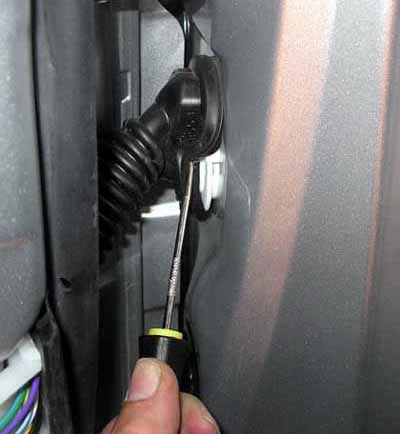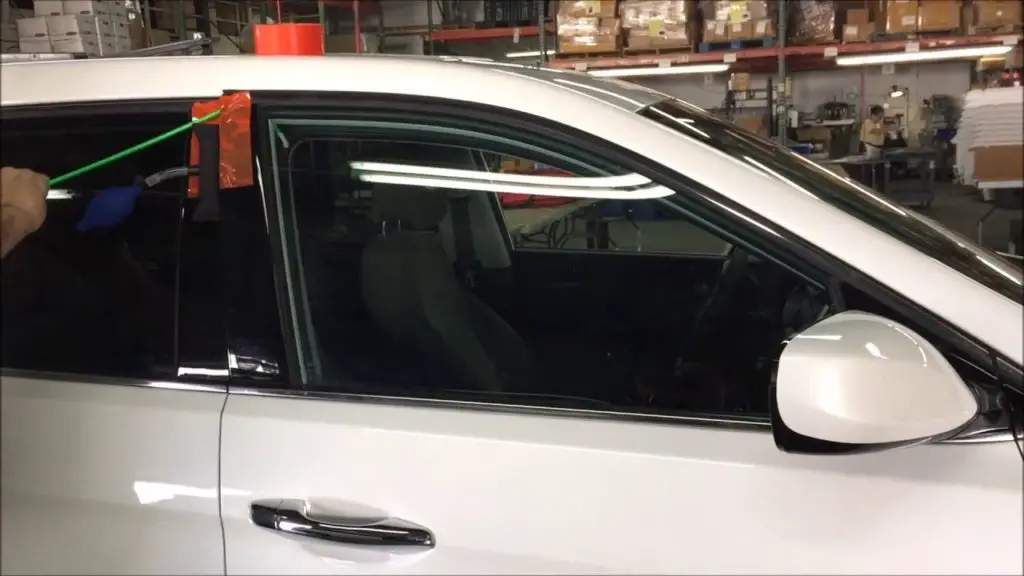To run speaker wire through a car door, remove the door panel and use a wire snake tool. Feed the wire through the rubber boot into the car.
Running speaker wire through a car door can enhance your audio experience significantly. This process may seem daunting, but with the right tools and steps, it becomes manageable. First, gather necessary tools like a wire snake, screwdrivers, and wire strippers.
Carefully remove the door panel by unscrewing and gently prying it off. Next, locate the rubber boot that houses the existing wires. Using the wire snake, feed the speaker wire through the boot and into the car. Ensure the wire is secure and reassemble the door panel. This method ensures a clean and professional installation, improving sound quality.
Introduction To Car Audio Setup
Proper speaker wire installation is key to a great car audio setup. Wires must be neatly arranged. A messy setup can lead to poor sound quality. It can also cause damage to the car’s electrical system. Secure connections ensure that the speakers work well. This also helps in avoiding any short circuits. Good quality wires are important for a clear sound. Poor quality wires can reduce the audio experience. Proper installation makes sure that the system lasts long. It also makes it easier to troubleshoot if there is a problem.
Tools And Materials Needed
| Tools | Materials |
|---|---|
| Wire Strippers | Speaker Wire |
| Screwdrivers | Wire Connectors |
| Drill | Electrical Tape |
| Panel Removal Tools | Cable Ties |
Preparation Steps
Get ready by gathering tools like wire, fish tape, and a screwdriver. Remove the door panel carefully, ensuring you keep all screws and clips intact.
Disconnecting The Battery
Before starting, disconnect the car battery to ensure safety. This prevents electrical shorts and possible injuries. Use a wrench to loosen the negative battery terminal. Remove the terminal and secure it away from the battery.
Removing Car Door Panels
Remove the screws from the door panel using a screwdriver. Keep the screws in a safe place. Gently pry the panel off using a trim tool. Disconnect any electrical connectors attached to the panel. Store the door panel in a safe location until you are ready to reattach it.
Choosing The Right Speaker Wire
The right speaker wire gauge is important. Thicker wires have lower numbers. A 12-gauge wire is thicker than a 16-gauge wire. Thicker wires carry more current. For longer distances, choose thicker wires. Shorter distances can use thinner wires. Always check your car’s speaker requirements.
Stranded wire is made of many small wires. It is flexible and easy to bend. Solid core wire is one thick wire. It is not as flexible but is more durable. Stranded wire is better for car doors. It bends easily around corners. Solid core might break when bent.
Credit: forums.justcommodores.com.au
Running Wire Through The Door
Running speaker wire through a car door involves carefully threading the wire to avoid damage. Start by removing the door panel and using a flexible wire snake to guide the speaker wire. Secure the wire to prevent interference with window mechanisms.
Locating The Factory Wire Path
Check the factory wire path inside the car door. Look near the hinges and door frame. Often, there is a rubber boot hiding the wires. This boot protects the wires from damage. Gently pull back the boot to see the wires. Make sure you don’t damage the existing wires. Use a flashlight if needed.
Feeding Wire Through The Boot
Feeding wire through the boot can be tricky. First, straighten the speaker wire. Push a stiff wire or coat hanger through the boot. This helps you guide the speaker wire. Tape the speaker wire to the coat hanger. Slowly pull the coat hanger back through the boot. The speaker wire should follow. Be patient and avoid tearing the boot.
Connecting Wires To Speakers
First, cut the speaker wire to the needed length. Strip about half an inch of insulation off the ends. Use a wire stripper for this task. Next, take a crimp connector and slide it onto the stripped wire. Use a crimping tool to secure the connection tightly. Ensure the wire does not slip out. This method makes the connection strong and reliable.
Soldering provides a solid connection for speaker wires. Heat the soldering iron and apply it to the wire. Add a small amount of solder to the connection. This helps the wire stay in place. Allow the solder to cool before moving the wire. Soldering ensures the wire will not come loose. This method is ideal for long-lasting connections.
Routing Wires Inside The Car
Hide the wires to make the car look neat. Use cable ties to bundle the wires together. Run the wires along existing pathways. Tuck the wires under the car’s trim. Secure the wires with adhesive clips. This keeps the wires out of sight. It also prevents them from getting tangled.
Keep speaker wires away from power cables. This reduces interference. Route the wires through safe areas. Avoid placing wires near moving parts. Stay clear of sharp edges. This prevents damage to the wires. Using shielding can also help. Shielded wires block interference. This ensures clear sound from your speakers.
Reassembling The Door Panel
Make sure all clips are aligned. Press the panel firmly to snap the clips into place. Check the edges to ensure they are flush with the door frame. Use screws and fasteners to secure the panel. Tighten each screw until it is snug. Avoid over-tightening as it can damage the panel. Reattach any trim pieces that were removed earlier.
Turn on the car stereo to test the speaker. Listen for clear sound without distortions. Check all connections if there are issues. Adjust the speaker placement if necessary. Test at different volumes to ensure quality. Recheck the wiring if the sound is not consistent. Fix any loose wires before finalizing the assembly.
Final Checks And Troubleshooting
Make sure the wires are not visible outside the car door. Tuck the wires neatly behind panels. Use zip ties to secure the wires. Check for any sharp edges that might cut the wires. Cover exposed wires with electrical tape.
| Issue | Solution |
|---|---|
| Wire gets pinched | Re-route the wire away from moving parts. |
| Sound quality is poor | Ensure connections are tight and wires are not damaged. |
| Wire falls out of place | Use clips or adhesive to secure the wire. |
Enhancing Sound Quality
Using acoustic treatments can greatly improve sound quality. Sound deadening materials reduce unwanted noise. These materials can be applied to the car door. Foam panels and sound mats are popular options. They help in absorbing vibrations. This makes the audio clearer. Improving acoustics helps in better music experience. Door panels can be removed for easy application. Make sure to cover the whole surface. Even small gaps can affect sound quality. Proper insulation is important for the best results.
Upgrading audio components can make a big difference. High-quality speakers deliver better sound. Amplifiers can boost audio performance. Better cables ensure clear signals. Subwoofers add depth to the sound. Tweeters enhance high frequencies. Crossovers can balance the audio. Head units with more features offer better control. Investing in good components is worth it. Each upgrade improves the overall sound experience. Make sure all components are compatible. This ensures seamless integration.

Credit: www.the12volt.com
Maintenance And Care
Running speaker wire through a car door requires careful planning and precision. Ensure wires are secured and protected from damage, enhancing audio performance and longevity. Proper routing prevents interference and maintains vehicle aesthetics.
Regular Inspection Tips
Check your speaker wires every month. Look for any signs of wear or damage. Make sure the wires are not loose. Loose wires can cause poor sound quality. Keep the wires clean. Dirt can affect the connection. Use a soft cloth to wipe them. Never use water or harsh chemicals. Always ensure wires are away from moving parts. Moving parts can cut the wires.
When To Consider Professional Help
Call a professional if you see any sparks. Sparks can be dangerous. If the wires are tangled, get help. Tangled wires can break easily. Hearing static noise? It’s time to call an expert. If unsure about anything, ask a professional. It’s better to be safe than sorry. Experts can fix issues quickly. They have the right tools and skills. Your car audio will sound better with professional help.

Credit: m.youtube.com
Frequently Asked Questions
What Gauge Wire For Car Door Speakers?
For car door speakers, use 16 to 18 gauge wire. Thicker wire ensures better sound quality and power handling.
Can You Run Speaker Wire With Power?
No, running speaker wire with power lines can cause interference. Keep them separate to ensure audio quality.
How Do You Run Speaker Wire Through Exterior Walls?
Drill a hole in the exterior wall. Insert a conduit for protection. Fish the wire through the conduit. Seal holes securely.
How Do You Discreetly Run Speaker Wire?
Run speaker wire discreetly by using cable raceways, hiding it behind baseboards, or running it through walls. Use flat adhesive wire or under carpets for minimal visibility.
Conclusion
Running speaker wire through your car door can seem complex. With the right tools and steps, it’s doable. Following these guidelines ensures a clean, professional installation. Enjoy enhanced audio quality without compromising your car’s aesthetics. Remember to double-check connections for optimal performance.
Happy driving with your upgraded sound system!

